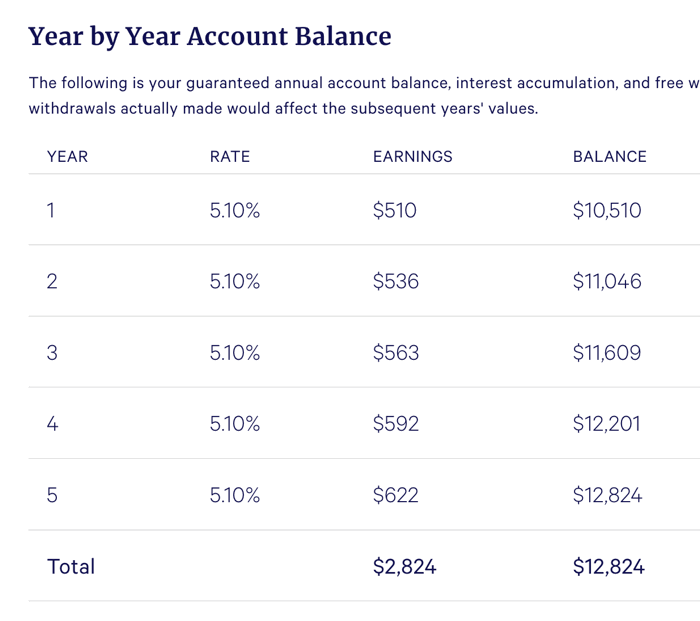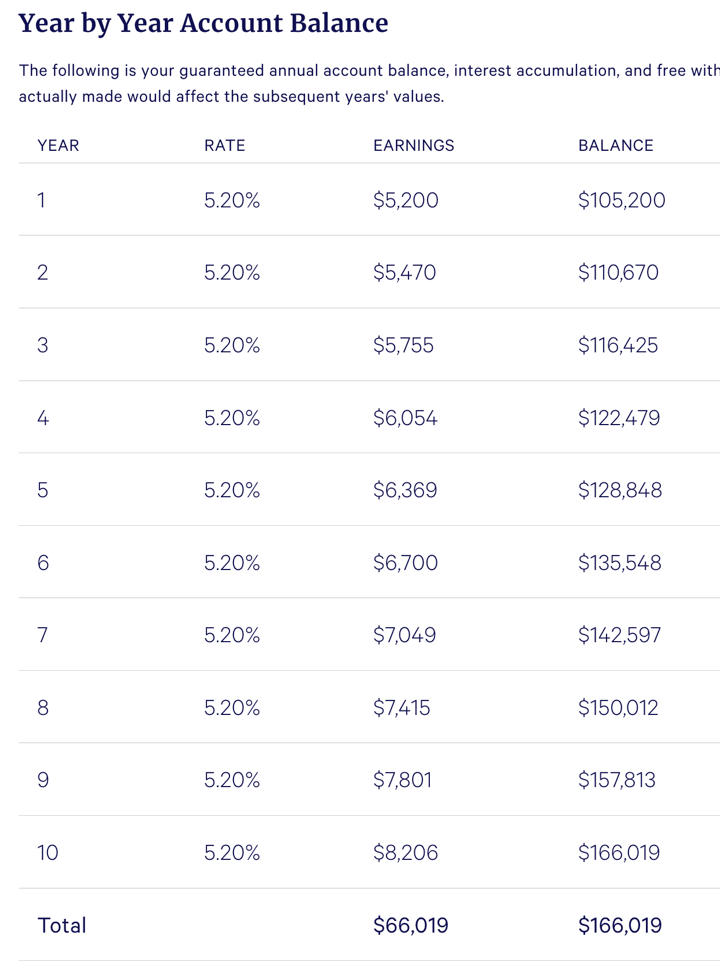
Many people hold a blanket assumption that all annuities are bad investments. Indeed, many annuities offer confusing promises with high hidden expenses, but I believe that certain annuities can be a very useful tool in retirement planning. First, the annuities must be transparent with clear, contractual guarantees such that you can directly comparison shop different products against each other. Two of the most simple types of annuities fit this definition:
- Single premium immediate annuities (SPIA). These are for lifetime income in retirement. You pay an upfront lump sum (single premium), and you immediately start receiving a guaranteed monthly income check for the rest of your life (or joint life).
- Multi-year guaranteed annuity (MYGA) fixed deferred annuity. These are for the accumulation stage. You put up your principal and similar to a bank certificate of deposit, you receive a fixed, guaranteed rate of return for a certain number of years. The investment growth is tax-deferred until age 59.5 when you withdraw your funds without the 10% IRS penalty. At that time, you could also roll into an SPIA.
Right now, MYGA rates are over 5% at the 5-year term and longer. (Image above is a sample chart of the growth of a $10,000 investment for a 5-year MYGA at 5.10%.) These rates are still higher than prevailing bank certificate rates and Treasury bond rates, while also offering the potential for tax-deferred growth while in the annuity wrapper.
There are additional wrinkles of course like early withdrawal penalties and annual withdrawal allowances, but the most important part is that you you can compare apples to apples at websites like Blueprint Income, Stan the Annuity Man, and ImmediateAnnuities.com.
MYGAs 101: Who are MYGAs a good fit for? They aren’t for everyone. I wondered how a MYGA would fit into something like the Standardized Personal Finance Advice Flowchart.
- You have adequate emergency funds.
- You don’t have debt besides primary mortgage.
- You have maxed out your available Roth IRA, 401k/403b/457, and HSA contributions.
- As part of your asset allocation, you would like more room for a CD/fixed-income style investment in a tax-deferred vehicle.
- You are saving for close to a traditional retirement age (i.e. don’t need any liquidity until age 59.5).
- You have looked at your state-specific guaranty limits and will stay below them for any single insurance issuer. You understand what the state guaranty system does and doesn’t provide.
I have written in more detail about MYGAs here:
- MYGAs Explained: Fixed Annuities with Higher, Guaranteed Rates Like CDs
- Example MYGA Fixed Annuity Statement and Purchase Experience. I renewed on 9/30/2020 at a 5-year rate of 3.35%, but realize that the 5-Year Treasury rate on the same date was 0.27%!
Low-Risk MYGA to SPIA $100,000 Example. Let’s say you are a risk-averse 50 yo investor (Texas resident) with $100,000 and want to retire at age 60. Based on actual rates available today (10/19/2022), you could put the $100,000 into a 10-year MYGA at 5.20% today and in 10 years you will have $166,019 due to the tax-deferred compounding. Both the initial and final values are well within the Texas state guaranty limits of $250,000 per insurer and the insurer Oceanview is rated A-.


I can’t tell you the future, but let’s say you are 60yo and have that $166,019 today. At current rates, with $166,019 you can get an immediate annuity from Nationwide Insurance paying between $955 a month or $11,500 a year (female) and $11,800 a year or $987 a month (male) for the rest of your life. This will stack with your Social Security to create a very stable income base to complement your riskier growth assets, even if you live to 110.
You are giving up the possibility of higher returns via the stock market in exchange for a slow-and-steady option with no stock market volatility. If you were going to invest in bonds anyway for part of your portfolio, this option offers the potential for higher returns in a tax-deferred wrapper (like with a Traditional IRA, you still owe taxes on gains at the end).

Bottom line: MYGAs can be a good tool to keep an eye upon. Each unique tool available has different features for the right situation. For example, a no-penalty CD offers the unique combination of a rate that you can always ratchet upward but will never go down (savings accounts can drop whenever they want), plus you have instant liquidity whenever you want. In contrast, this MYGA offers a significantly higher rate with tax-deferral benefits that can really add up over time, but you have extremely harsh early withdrawal penalties and you must do your due diligence and diversify to minimize any risk involved. You might find them useful for a portion of your portfolio, or you might not ever need either one.
 The Best Credit Card Bonus Offers – 2025
The Best Credit Card Bonus Offers – 2025 Big List of Free Stocks from Brokerage Apps
Big List of Free Stocks from Brokerage Apps Best Interest Rates on Cash - 2025
Best Interest Rates on Cash - 2025 Free Credit Scores x 3 + Free Credit Monitoring
Free Credit Scores x 3 + Free Credit Monitoring Best No Fee 0% APR Balance Transfer Offers
Best No Fee 0% APR Balance Transfer Offers Little-Known Cellular Data Plans That Can Save Big Money
Little-Known Cellular Data Plans That Can Save Big Money How To Haggle Your Cable or Direct TV Bill
How To Haggle Your Cable or Direct TV Bill Big List of Free Consumer Data Reports (Credit, Rent, Work)
Big List of Free Consumer Data Reports (Credit, Rent, Work)
The main problem I have with annuites is that they are NOT insured by federal or state government, and you are depending on the claims paying ability of the issuing company. And higher rates are offered by ones with lower credit ratings. So, the extra interest is for this extra risk you are taking.
That is certainly a valid concern, but if you are talking about the chance of a loss between a regulated insurance company when you own an insurance contract under the state guaranty association limits, you have to balance that against all the other wide range of credit out there. I sleep a lot better at night holding this than an individual corporate bond. Is it worth 1% more a year? 2% more? 3% more? That’s a harder call.
Unfortunately, inflation is running at 8%+. As long as this continues, you’re losing 3% a year on these investments. I think a 20 year TIPS, currently yielding 2% above inflation on the secondary market, is a safer bet. You’re getting approx 10% yield now, and inflation would have to drop below 3% to achieve breakeven with the annuity. That may happen, but I doubt it will drop below 2.5%, and I would rather give up that 0.5% to get certainty that my investment won’t be destroyed by runaway inflation.
Inflation is definitely the main reason I am hesitant to go with an SPIA which might run for 20 to 30+ years. I would still consider annualizing a portion, just not all. The overall data suggest that my total spending in my late 70s and 80s will drop considerably anyway compared to 60s.
I agree that TIPS are looking attractive again, especially if you have the tax-deferred space for them. But I also split my bonds between TIPS and nominal, and this effectively lets me put some bonds in additional tax-deferred space.
I would add auto loans to a reason that they could be useful as well. My auto loan I opened up 2 months ago is a 5 year 2.25% loan. I could have paid cash but I currently have $20k of I Bonds earning 9.62%. As soon as I bond rates go significantly lower, I’ll cash them out and pay off the loan. If I was 55+ and didn’t have to worry about the pre 59.5 penalty, MYGA could serve a similar purpose. Easy profit, assuming you can cashflow it.
please can you illustrate what options do you have , in your example after the 10years at age 60, and interest rate is back at close to 0 from the federal reserve, are you forced to move into an SPIA at 0+.xx percent annuity , or can you roll into an ira without penalty ?
My understanding is that you can just cash out at age 60 and pay the interest on all capital gains, or roll into any annuity you want. Another MYGA, SPIA, etc.
Jonathan. Very informative post, something I have been considering for a while, thank you. I am wondering about one thing: If you buy a MYGA within the state guaranty association limit, is there any reason not to buy the highest rate regardless of the company credit rating? After all, the state association will guarantee the value of the MYGA at the time if something happens. I only found a relatively small number of insolvencies in the US over the last 30 years.
My own personal decision was to indeed did buy basically the highest rate from a still guaranty-covered annuity company. Of course there may be some sort of situation where this turns out poorly such as it fails and the guaranty process goes wrong. I am/was willing to take that risk, and my purchase was not more than 5% of total portfolio. I am also a proponent of buying a ladder of annuities from different insurers.
Thanks
Annuities! Just like advanced calculus, there are things in this world that I will never master!
I’ve tried to educate myself, but as this and your past articles about annuities point out, there is so much to decipher when reading the fine print, hidden fees that are not apparent at first read, etc. I believe you are getting better educated about them; more so than I.
In my area, there is a weekly radio show with a guy who talks money matters and offers the free steak dinner seminar (woo hoo for Ruth Chris). He is upfront in his advertising of annuities and tries to explain them. I listen so that I can try and learn more (with a skeptical understanding that he’s just trying to sell something).
He sends out emails and hosts webinars on money, debt, and annuities. Just this morning, he had a 20 min webinar on a new Allianz annuity product that will pay a 32% bonus on money you start with. I can’t figure out what type of annuity it is. I’d like to link it here (I don’t know if I can) but hopefully Jonathan can look at it and give me his opinion – is it just another annuity sales pitch of the same ole annuity shtick?
Thanks in advance
https://register.gotowebinar.com/recording/recordingView?webinarKey=885788986260572000®istrantEmail=mifoya2877%40fsouda.com
Which would be a better option…A Deferred Income Annuity (4 year), vs MYGA to SPIA (4 years)?
Would the extra interest gained in a MYGA and then rolling it into a SPIA be a better choice than a simple Deferred Annuity with payment deferred to begin in 4 years?
SPIA rates will be different in 4 years, so I don’t know if I could answer that.